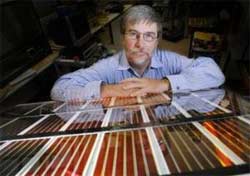
'Nanostitching' could make aeroplanes 1o times stronger
MIT engineers are using carbon nanotubes only billionths of a meter thick to stitch together aerospace materials in work that could make airplane skins and other products some 10 times stronger at a nominal increase in cost. Moreover, advanced composites reinforced with nanotubes are also more than one million times more electrically conductive than their counterparts without nanotubes, meaning aircraft built with such materials would have greater protection against damage from lightning, said Brian L. Wardle, the Charles Stark Draper Assistant Professor in the Department of Aeronautics and Astronautics.
How does nanostitching work? The polymer glue between two carbon-fiber layers is heated, becoming more liquid-like. Billions of nanotubes positioned perpendicular to each carbon-fiber layer are then sucked up into the glue on both sides of each layer. Because the nanotubes are 1000 times smaller than the carbon fibers, they don't detrimentally affect the much larger carbon fibers, but instead fill the spaces around them, stitching the layers together.
"So we're putting the strongest fibers known to humankind [the nanotubes] in the place where the composite is weakest, and where they're needed most," Wardle said.
Read full article at: http://web.mit.edu/newsoffice/2009/nanostitching-0305.html







![Reblog this post [with Zemanta]](http://img.zemanta.com/reblog_e.png?x-id=c0912daa-0b2d-4709-9e27-5d10289dc976)


![Reblog this post [with Zemanta]](http://img.zemanta.com/reblog_e.png?x-id=06e32066-395b-4bd0-8659-35dc624ee961)


